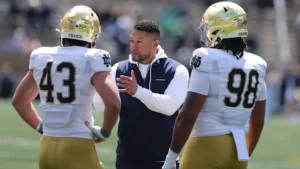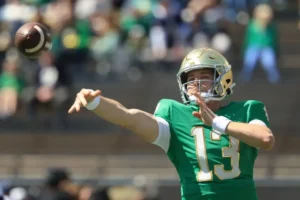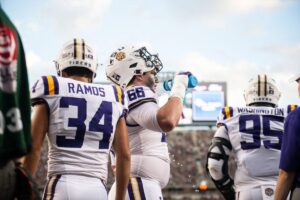
From Gridiron Glory to Golden Generosity: LSU Star’s NIL Blessing for High School Champions
In an inspiring display of paying it forward, LSU Football wide receiver Chris Hilton Jr. has announced his intention to donate a portion of his Name, Image, and Likeness (NIL) earnings to his alma mater, Zachary High School, specifically to fund the championship rings for the school’s victorious boys’ basketball team. This heartwarming gesture from a prominent college athlete underscores the burgeoning potential for NIL deals to extend beyond individual enrichment and positively impact local communities and the institutions that helped shape these young talents. Hilton’s decision resonates deeply, highlighting a connection to his roots and a desire to celebrate the achievements of the next generation of athletes at his former school.
The advent of NIL in the collegiate and, increasingly, high school sports landscape has opened up unprecedented avenues for athletes to capitalize on their personal brand. Since the NCAA’s interim policy in June 2021, student-athletes have been permitted to earn compensation through endorsements, sponsorships, and various other activities related to their name, image, and likeness. This seismic shift has not only altered the financial dynamics of college athletics but has also begun to ripple through the high school level, with numerous states now allowing high school athletes to engage in NIL activities under certain regulations.
Hilton, a Louisiana native who achieved significant recognition during his high school career at Zachary, understands the profound significance of a state championship and the symbolic value of the rings that commemorate such hard-earned success. By earmarking a portion of his NIL earnings for this purpose, he is not just providing financial assistance; he is offering tangible recognition of the basketball team’s dedication and triumph. This act of generosity can serve as a powerful motivator for current and future Zachary High athletes, demonstrating that success can be a stepping stone to giving back and supporting the community.
The broader implications of NIL extend to the ability of college athletes to maintain connections with their high school programs. In many instances, these athletes credit their foundational development, both athletically and personally, to the coaches, mentors, and support systems they encountered during their high school years. Hilton’s donation exemplifies this appreciation and fosters a continued link between a rising college star and the program that nurtured his early aspirations. It can inspire other former high school standouts now competing at the collegiate level to consider similar ways of giving back, strengthening the bonds within the athletic community.
Moreover, this kind of initiative can have a positive influence on the perception of NIL deals. While some critics have raised concerns about the potential for NIL to commercialize amateur sports excessively, acts of altruism like Hilton’s demonstrate the potential for these opportunities to be used for benevolent purposes. Instead of solely focusing on individual gain, athletes can leverage their NIL earnings to support causes they believe in, whether it’s their former high school, local charities, or initiatives that promote youth development.
The impact of such donations can be multifaceted. For a high school athletic program, receiving financial support for championship rings can alleviate budget constraints and ensure that deserving athletes are properly recognized for their achievements. Beyond the monetary value, it can also instill a sense of pride and accomplishment within the team and the wider school community. Knowing that a former student-athlete, who has gone on to achieve success at a high level, remembers and supports their accomplishments can be incredibly inspiring for the current players.
Furthermore, Hilton’s gesture can encourage a culture of giving back among young athletes. By witnessing a successful college player using his resources to support his former high school, current student-athletes may be more inclined to consider how they too can make a positive impact in their communities as they progress in their athletic careers. This can foster a sense of social responsibility and civic engagement among young people who are often in the public eye.
The NCAA’s evolving stance on NIL reflects a broader recognition of the rights of student-athletes to benefit from their name, image, and likeness, similar to their peers in other fields. While the primary beneficiaries of NIL deals have often been athletes with significant social media followings or those in high-profile sports, the potential for these earnings to be channeled towards community benefit is becoming increasingly apparent. Hilton’s donation serves as a compelling example of this positive potential.
As the NIL landscape continues to mature, it is likely that more college athletes will find creative ways to use their earnings to support causes and institutions that are meaningful to them. This could include funding scholarships, upgrading facilities at their former high schools, or supporting youth sports programs in their communities. These acts of generosity can help to shape a narrative around NIL that extends beyond individual financial gain and highlights the potential for athletes to be impactful philanthropists.
In conclusion, Chris Hilton Jr.’s decision to donate a portion of his NIL money to fund championship rings for the Zachary High School boys’ basketball team is a commendable act that underscores the positive potential of NIL opportunities. It demonstrates a strong connection to his roots, a desire to celebrate the achievements of young athletes, and the capacity for college stars to make a meaningful impact on their communities. This gesture serves as an inspiring example for other athletes and highlights the evolving role of NIL in fostering a culture of giving back within the world of sports. As the NIL era unfolds, it is acts like these that will help to define its legacy and demonstrate its potential to benefit not just individual athletes but also the communities that have supported their journey.





